
It’s a familiar
strategy for those seeking to demonize vulnerable groups and restrict their rights: claim such actions are done to “protect the children.” That phrase has been weaponized as an argument
across the country by far-right politicians, groups, and media personalities seeking to curtail the human rights of LGBTQ+ youth.
“There’s a big reason the right wing focuses on
language like this," GLADD Chief Communications Officer Rich Ferraro told Marketing Daily. “They know … that fear tactics work.”
So the nonprofit LGBTQ+
rights advocacy organization, along with global creative agency Ogilvy, is flipping the script and setting the record straight with a new campaign illustrating that the real threats to children
come from the kind of hate and bigotry that attempt to hide behind such bad faith claims.
advertisement
advertisement
“Protect This Kid” enlisted help from a roster of LGBTQ+ celebrities across various fields
to share their stories as “Protect This Kid Heroes.” The list includes: queer stand-up comedian and actress Margaret Cho; bisexual actress and comedian Sherry Cola; queer actress
Beanie Feldstein (“Booksmart”); drag queen (and “RuPaul’s Drag Race” season 11 winner), fashion designer, and rapper Yvie Oddly; and Chris Mosier, the first transgender
athlete to represent the United States in international competition, and a trans rights policy advocate.
“We aimed for a very diverse and representative group of queer
people” Ferraro said, which included the campaign’s director and production crew. "It's important people don’t [just] see the same [white cis queer] people telling these
stories. It was important for us to be representative of everyone.”
Set to Billie Eilish’s hit from "Barbie," “What Was I Made For?,” the campaign hero ad opens with an explanation that “Anti-LGBTQ groups are using a misleading message to spread hate,” quoting the
message: “Protect our children.” It then goes on to declare, “We agree,” and then pairs the statement “Protect this kid” with childhood photos of GLADD’s
celebrity partners, along with lines completing the phrase, such as “from hate,” “fear,” and “bullying.”
The ad concludes by driving viewers to a campaign
landing page that invites visitors to share their own childhood photos and positive messages, as do a series of OOH installments across the country.
The brief for the campaign arrived a year ago in the wake of a record-breaking wave of proposed anti-LGBTQ+ legislation introduced by far-right Republican politicians, overtaking the number
of such bills introduced the previous year (a record since eclipsed by the number of such bills introduced in 2024), with a particular emphasis on legislation seeking to eliminate the rights of trans
youth and their families.
“We were saying if we want to shift this narrative, we need everyone to share stories instead that [show] young people are also LGBTQ and those young people
need support, not anti-LGBTQ legislation that has been proven time and again to cause them harm,” Ferraro explained. “What they need is affirmation to grow up and be who they
are.”
The campaign also is an attempt to reach non-LGTBQ+ parents exposed to misinformation about the supposed need to “protect children '' from acknowledging LGTBQ+
identities. “It’s not just the legislation, it's about the broader culture and being inclusive.” Ferraro said.
In order to reach the widest audience of persuadable
people exposed to misinformation, the campaign involved testing early iterations of its messaging. When an early version that included the (factually accurate) description “far right” in
relation to harmful anti-LGBTQ+ legislation caused some viewers to tune out the message, the final version was changed to solely focus on “anti-LGBTQ” efforts.
“We were
targeting the moveable middle," Lisa Bright, chief creative officer of Ogilvy California and Chicago, explained, calling it “important to strike the right balance” and adding,
"the engagement piece is really important, because we want to flood and shift the algorithm.”
The group was particularly focused on reaching audiences of mothers of school-aged
children, and people over the age of 60, Ferraro explained, “Those two audiences are movable on these issues. We need to create more media now to reach them to combat [misinformation and
disinformation].”
A search for “Protect This Kid” now turns up content from the campaign, where weeks ago it would have been “all this awful content,” Bright
said. “ The goal is that it will shift perceptions.”
To that end, the OOH campaign spans beyond the typical large markets of New York and Los Angeles to include states such as
Florida and Texas, where some of the worst anti-LGBTQ legislation has been introduced. Ferraro said it was important for the campaign to “go into those ecosystems” to deliver its
message.
The campaign will extend through Pride Month, anticipating a continuation of anti-LGBTQ+ hate campaigns targeting companies celebrating Pride.“During Pride 2023, a fringe group
of loud anti-LGBTQ activists criticized brands on social media by maliciously and inaccurately claiming that LGBTQ-inclusive campaigns and Pride products harm children,” Ferraro told
Marketing Daily.
“At a time when over 20% of Gen Z is LGBTQ and a supermajority are allies of the community, inclusion is not only good for the world, but for
futureproofing a business.”